Samsung QN85A Neo QLED 4K TV
One minute review
The QN85A Neo QLED is slim enough to look very good hanging on a wall. It’s adept enough with both black and white tones to allow contrasts to pop from the screen. It can output brilliant colors, draw edges with absolute confidence and it has nice wide viewing angles. It’s blessed with one of the very best smart TV interfaces around. And it’s able to support all the clever features of your next-gen games console (as long as you only own one of them).
And it does all of this without asking silly money in exchange. Oh, we know £1499 for a 55in screen isn’t anyone’s idea of a bargain, but equally we know you tend to get what you pay for where products like this are concerned – and the Samsung QN85A is proper value for money.
The QN85A isn’t perfect – its sound is nothing to write home about, it can’t upscale properly low-resolution content with much conviction and it will occasionally have ‘a moment’ when the on-screen motion gets particularly testing. But taken as a package, and with the price/screen-size ratio uppermost in your mind, the QN85A emerges from this test with a lot more in the ‘positive’ column than in the ‘negative’.
- New Samsung TV 2021: what's coming this year
Price and availability
The 55-inch Samsung QN85A reviewed here – along with the 65-inch, 75-inch and 85-inch models that are also available – is on sale now.
Customers in the United States should expect to pay $,1599 – the company’s American website is currently promising a $200 discount, but that offer is due to expire any moment now. In the UK it launched at £1,799 but is now routinely available for £1499. Australian customers aren’t as yet able to enjoy any price-cutting or temporary discounts, and as such should brace themselves to spend around AU$2,999.
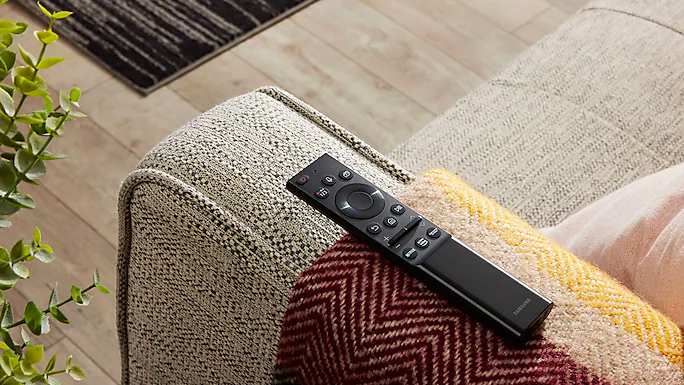
Design
- Slim, unobtrusive design
- Contrasting silver bezel
- Substantial pedestal stand
Are you expecting some kind of flight of fancy where the design of the Samsung is concerned, a tearing up of the rulebook? Hopefully not, because if you are you’re going to be disappointed. The Samsung QE55QN85A, in design terms at least, is absolutely by the book. It’s a big screen, surrounded by a small bezel, standing on a single (and quite hefty) foot that leaves plenty of room beneath the bottom of the screen for a soundbar. Line it up alongside any number of other new TVs and you’d be hard pressed to pick it out.
That’s not a bad thing, though – the design of a television isn’t supposed to draw attention to itself. The 55-inch QN85A is a tidy 706 x 1227 x 27mm (hwd), with only a brief silver bezel containing that great big expanse of screen. And look at that last number again – the QN85A measures a consistent 27mm deep, which makes it a much more wall-hangable proposition than the majority of new televisions. LG’s Gallery G1 OLED TV, at 23mm, is possibly the only premium screen that’s slimmer than this Samsung alternative – and at £1999 for a 55-inch model, it’s a fair bit more expensive.
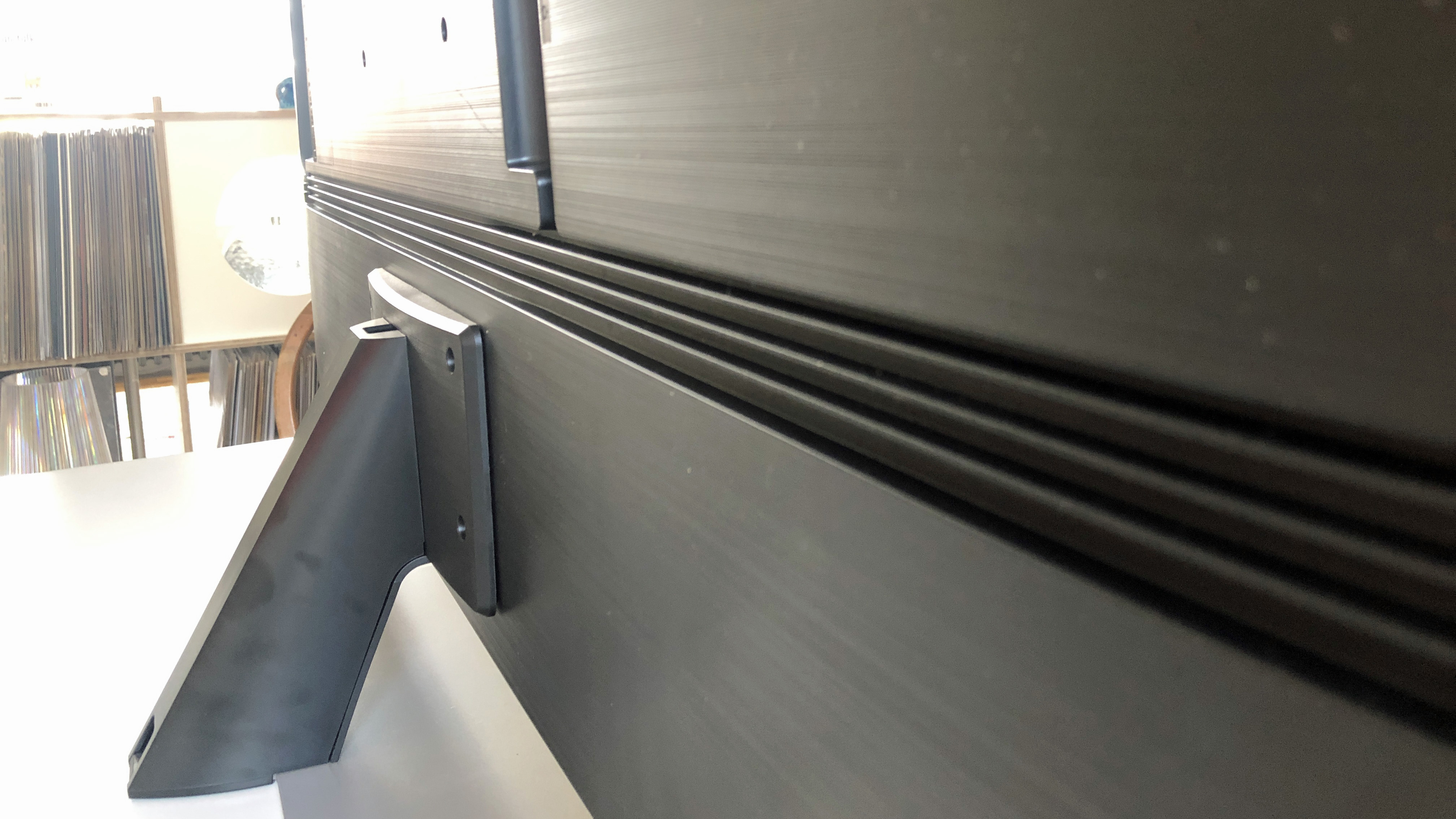
The rear panel is home to four HDMI inputs. One of them covers every next-gen console-friendly HDMI 2.1 standard, including FreeSync Premium Pro, ALLM, VRR, 4K/120Hz and all the rest, while another is eARC-enabled. Alternative inputs include a couple of USB sockets, an Ethernet input, and aerial binding posts for the pair of integrated TV tuners. A digital optical output completes the line-up of physical ins and outs. Wireless connectivity runs to Bluetooth 5.2 and dual-band wi-fi.
The QE55QN85A is a Mini LED screen – or, as Samsung’s marketing department insists, ‘Neo QLED’. It’s worth noting that, while the QN85A has the same number of dimming zones as the 55-inch version of the range-topping QN95A (a touch over 500), its peak brightness is a ‘mere’ 1,500 nits where the QN95A can summon close to 2,000. Still, in this context ‘1,500’ is a pretty big number, one that any number of OLED TV owners would sacrifice a kidney for.
As far as HDR compatibility goes, it’s Samsung business as usual – meaning HLG and HDR10+, but no Dolby Vision. Samsung can go on at length about all the reasons its TVs don’t require Dolby Vision, but the simple fact is that consumers – especially consumers spending a considerable amount of money on a new television – usually expect every major specification box to be ticked. The lack of Dolby Vision will no doubt irk some, then, especially given its the favored HDR format of both Netflix and Apple TV.
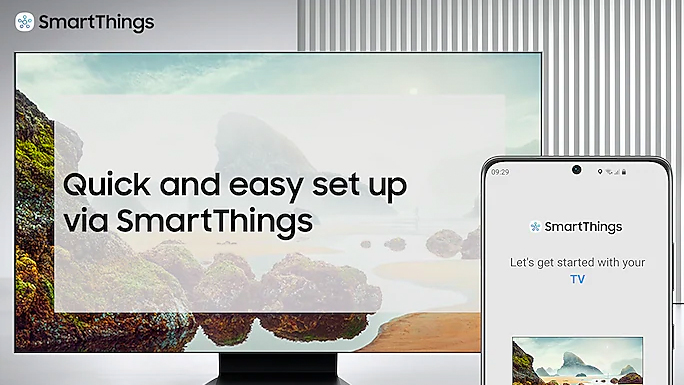
Smart TV (Tizen OS)
- Great Tizen smart TV interface
- Choice of remote controls
- Smart Things app compatibility
It’s a testament to just how impressive the Tizen smart TV interface is that Samsung only needs to fiddle about with the minutiae of its performance to maintain its position as one of the very best around. Other brands (they know who they are) have had to make giant strides to deliver anything as logical, straightforward and user-friendly as the interface fitted to the QN85A. It’s a paradigm of good sense.
There’s a wide selection of content available, including every UK broadcaster’s catch-up service, and streaming opportunities from the likes of Apple TV, Disney Plus, Amazon Prime Video and Netflix. The absence of Freeview Play is a minor niggle, but in any event you’ll never be short of stuff to watch.
Set-up is straightforward, thanks to similarly logical and concise menus, and while there’s a degree of fiddling needed to get motion-handling just right the rest of the process doesn’t take long at all. Getting a workable picture takes moments, and getting a picture that’s satisfying on every level doesn’t take all that much longer.
As is common with many new Samsung TVs these days, the QN85A is supplied with a pair of remote controls. One is a cheap-feeling controller with too many buttons, many of which are too small, while the other is an altogether nicer, more elegant and more stripped-back affair that just covers major control inputs.
Voice-assistance is available too, as long as you don’t want to use Siri. Amazon Alexa is on board, as is Google Assistant – and Samsung’s own Bixby assistant is available too, for those happy to take a punt on it.
Samsung’s half-decent Smart Things app is also compatible with the QN85A. It’s a nice-looking, clean and stable interface, but it makes you jump through quite a few hoops before it’s prepared to let you adjust the volume on your own TV.
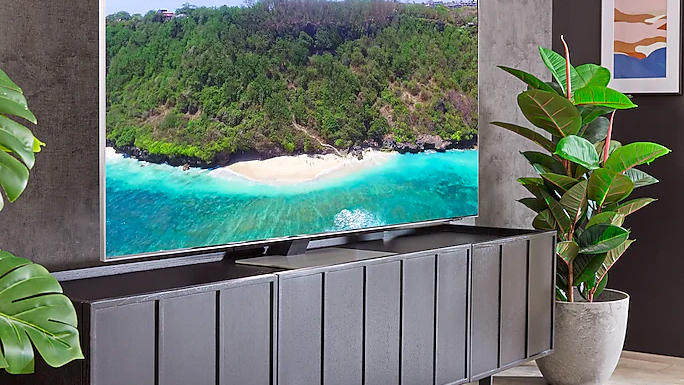
Picture quality
- Punchy, informative 4K images
- Impressive upscaling (up to a point)
- Another Mini LED tour de force
It’s always surprising how quickly remarkable new technologies are assimilated. Just take Mini LED TVs, for instance, which was only introduced to Samsung, LG and Philips TV ranges in 2021 – but already we’ve gone from marvelling at how LCD-based screen technology can deliver such deep and detailed black tones, and such stunningly well-controlled backlighting, to simply expecting it. In summary, the QN85A doesn’t disappoint.
Displaying a 4K HDR stream of Black Panther via Amazon Prime Video, the Samsung impresses across the board. When assessing the screen’s black levels, the QN85A is almost startlingly adept. The screen’s ability to deliver deep, detailed and wide-ranging black tones makes for an absorbing viewing experience – and the Samsung’s numerous compact and tightly controlled dimming zones means backlighting is precise. So when a small item of jewelry glints in an otherwise-dark scene, there’s no haloing around it or blooming of the brighter area – just a convincing light in the darkness.
And though the QN85A can’t muster the peak brightness of its more expensive QN95A sibling, it’s plenty bright enough. And the white tones it generates are every bit as nuanced, detailed and clean as the black equivalent –and, as a consequence, contrasts are extensive.
The same film showcases the QN85A’s wide and convincing color palette. Of course, it’s possible to spend any amount of time finessing the QN85A’s color response – but everyone else can switch to the ‘adaptive picture’ intelligent picture mode and enjoy the vibrancy and seemingly limitless variation of the color performance that results. There’s ample opportunity for the screen’s processor to examine skin-tone and skin-texture here, too, and it’s never less than poised and expressive.
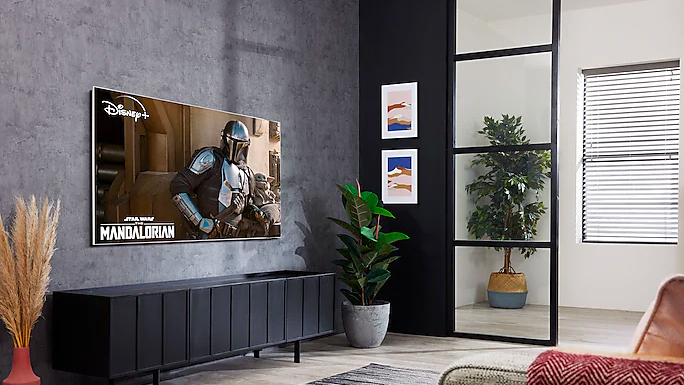
Edge definition is stable and assured, while depth of field is never less than persuasive. Sometimes the CGI elements of a film like this can take on a rather artificial cast in the hands of less capable screens, but the QN85A is adaptable enough to make these transitions all-but seamless. The movie’s relentless, rapid motion causes few alarms, either – in fact, on the very rare occasions that the screen can be seen to be working hard to stay in control of on-screen movement, it only serves to emphasise how authoritative the Samsung otherwise is.
The Samsung’s IPS panel offers decently wide viewing angles (good) and a little more reflectivity than is absolutely ideal (not quite so good). Take a bit of care with positioning, though – both of the screen and your position relative to it – and picture performance is admirable.
Step down to some Full HD content and the QN85A proves a competent upscaler, even of thoroughly testing content like the BBC One HD coverage of Wimbledon. Detail levels stay high, contrasts stay wide – and while the Samsung’s travails with motion become more readily apparent, it’s still one of the better performers this sort of money can buy. Yes, there’s a softening of the overall image, and some of the nuance and variation previously available from the color palette goes astray, but the QN85A is never less than watchable.
‘Watchable’ is a relative term when it comes to upscaled content of a lesser standard, though. No one’s expecting miracles when watching a standard-definition 4:3 re-run of Only Fools and Horses but the Samsung’s Neo Quantum Processor 4K does throw in the towel somewhat – the images it comes up with are noisy, ill-defined and rough. It’s like an approximation of a television broadcast.
Steer clear of the antique stuff, though, and the QE55QN85A is at the very least an enjoyable watch and at best pretty absorbing.
Audio performance
- Four speaker drivers
- 60 watts of power
- Q Symphony-compatible
Samsung talks a good game with the audio systems it’s fitted to its 2021 range of TVs, but these are the real headlines: the sound the QN85A makes relates to the pictures it delivers in the same way a rowing boat relates to a speedboat.
Two full-range drivers at the top of the frame, and another two at the bottom, powered by 60 watts of amplification and designed to offer a degree of synchronicity between on-screen movement and audio placement, looks admirable when written down. In practice, though, the Samsung is a rather boneless listen – it’s not actively unpleasant, and it doesn’t get too shouty at volume, but there’s a bluntness about the sound it makes that’s quite strongly at odds with its images.
So, not for the first time and certainly not for the last, we’d quite firmly point you in the direction of our list of the best soundbars around. You should pay particularly close attention to Samsung’s current range, because the ‘Q Symphony’ arrangement here means the screen’s audio system can join in with, rather than be entirely replaced by, a Q Symphony soundbar.
Should I buy the Samsung QN85A?
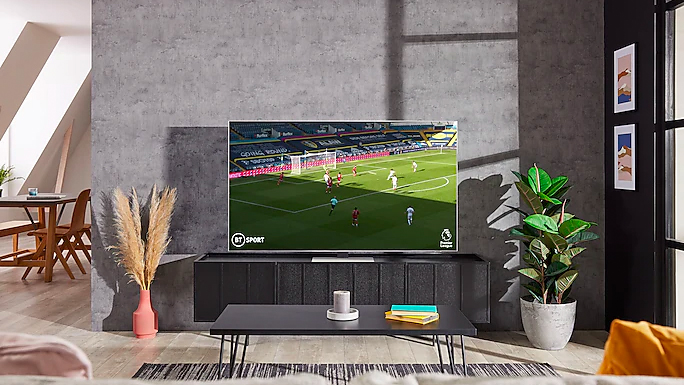
Buy it if…
You want everyone to see it
The combination of wide viewing angles and a nice slim profile make the Samsung a prime candidate for wall-hanging.
You’re a control freak
Operate it with your voice. Or an app. Or one of the TWO remote controls.
You watch high-quality content
4K HDR stuff looks an absolute treat on the QN85A.
Don't buy it if…
You like the old times best
Upscaling elderly content is not the Samsung’s strongest point.
You’ve paid extra for a whistles-and-bells Netflix subscription
No Dolby Vision here, so you won't get the most out of a premium Netflix sub.
You think a TV should sound as good as it looks
This one doesn’t (but then very few do). You can always supplement with a good soundbar, though.
- Check out the best Samsung TVs available today
0 comments:
Post a Comment